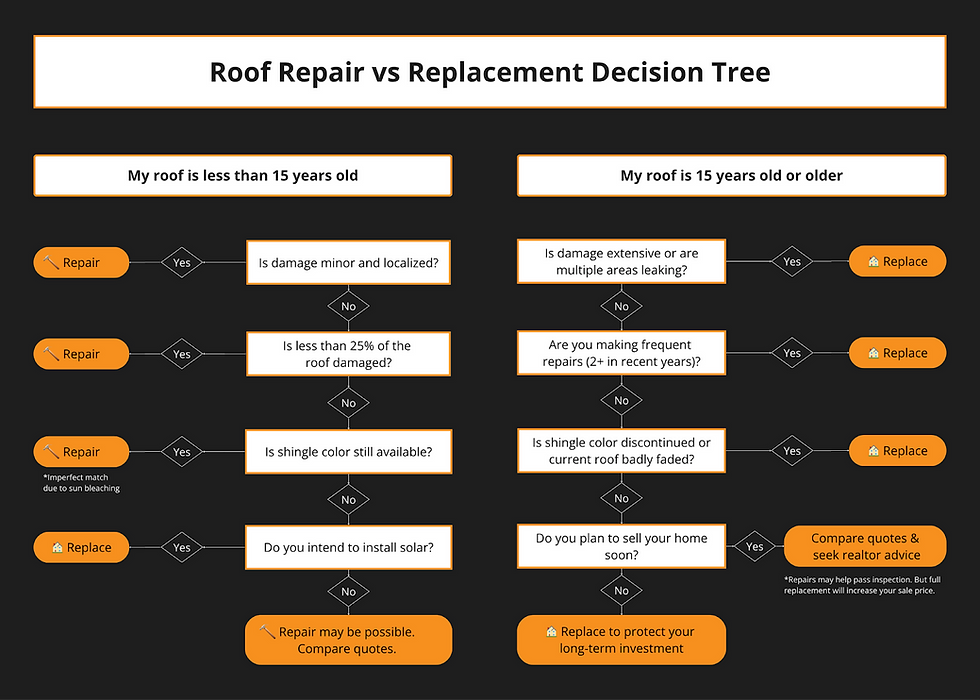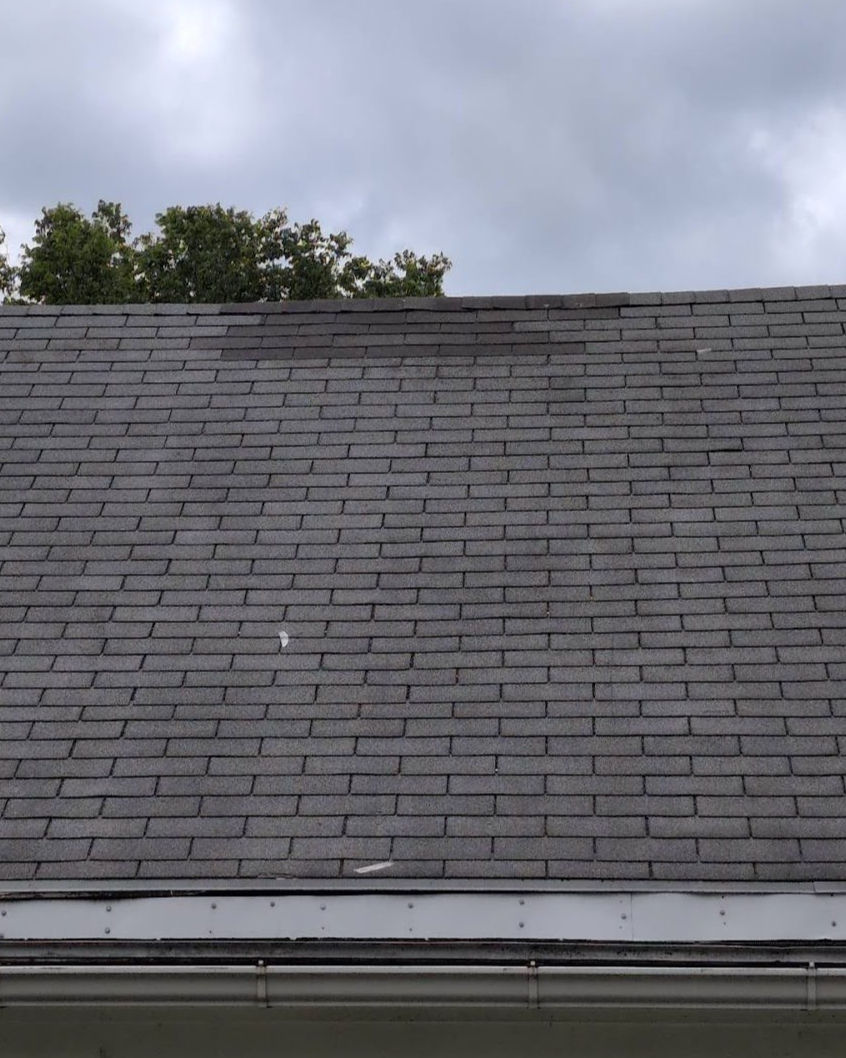When to Repair vs. Replace Your Roof: A Guide for Wisconsin Homeowners
- Mike Mannion

- Jul 22
- 4 min read
Updated: Nov 5
Your roof protects your greatest investment: your home or business. So when damage or aging sets in, knowing whether to repair vs replace your roof can be a tough call. Roofs are expensive, and in theory, should only need to be replaced a few times in a building's lifetime. But waiting too long to replace can lead to even more costly repairs inside your home, or even denied insurance claims if a major leak occurs and the insurance company identifies negligence. This guide helps you assess the severity of issues and determine the smartest next step for your situation.

Start with a Professional Inspection
While you can spot obvious issues like missing shingles or water stains, the full picture often lies beneath the surface. A certified contractor can:
Check for hidden moisture damage or rotting deck boards
Evaluate flashing, sealants, and underlayment
Assess whether repairs will truly resolve the issue or just delay it (see NRCA guidelines)
When Roof Repairs Make the Most Sense
Repairs are often a smart option if:
Damage is minor and localized
The roof is under 10–15 years old
Materials are still available and can be color-matched
There are no signs of broader structural damage
Common Repair Scenarios:
Small leaks around chimneys or vents
A few missing or damaged shingles
Flashing or sealant failure
Minor hail or storm damage (depending on insurance)
Leaks only occur after major storm/rain events
🛠️ Pro Tip: If your flashing wasn’t replaced during your last roof installation, it may now be a weak point. Damage near flashing can uncover rotted decking or larger vulnerabilities that may not seal properly. Repairs here should be done carefully—or may warrant broader replacement.
When Roof Replacement Makes More Sense

Roof Replacement is Often Smarter if:
More than 25% of your roof is damaged
Multiple areas are leaking or stained, even after minor storms
Shingles are curling, cracking, or showing bald spots (excessive granule loss)
Roof deck is sagging or structurally compromised
Your home insurance company has told you it is needed (you could lose coverage if you don’t do it by their deadline)

Other Factors That Support Full Replacement:
Roof is over 15–20 years old
Manufacturer has discontinued your shingle color and you will not be satisfied with an obvious visual patch
New shingles won’t match the old (hurts curb appeal)
Cost of ongoing repairs is adding up
Water Warning:
Every patch adds complexity to your roof. After repeated repairs, tracing new leaks becomes difficult and water can travel in unpredictable ways, costing more in the long run.
Insurance Insight:
Significant storm damage, especially from hail or high winds, may qualify you for a full replacement under your homeowner’s policy. But don’t wait! Delays can jeopardize your claim.
Thinking About Solar?
Don’t install solar on a roof near the end of its life. Uninstalling and reinstalling a solar system adds major costs and logistical headaches. Instead, consider solar shingle integration as part of your replacement (learn about CertainTeed Solstice Shingles).

Roof Replacement can be a Smart Upgrade Opportunity
Roof replacement can be the perfect moment to:
Add solar shingles and lock in long-term energy savings
Replace or upgrade gutters, soffit, or fascia
Enhance your home’s curb appeal and resale value
Upgrade to the next generation of shingle technology (3-tab to premium architectural shingles)
Financial Tip: In some cases, the cost of repairing an older roof exceeds the cost-per-year of a brand-new one. Add in potential tax incentives or insurance reimbursements, and replacement can become a smarter investment.
Should you Replace or Repair your Roof if Planning to Sell Soon?
If you’re prepping your home for sale:
Repairs might make sense as a low-cost fix to pass inspection or preserve curb appeal
Replacement can boost market value, appeal to buyers, and offer transferable warranties
Roof Repair vs. Replacement: Warranty & Insurance Considerations
Check if your roof is still under a Manufacturer Warranty for the materials or Workmanship Warranty for the installation (CertainTeed SureStart PLUS Warranty)
Contact your original contractor (or the manufacturer if they’re no longer in business)
Avoid unauthorized or DIY repairs, which may void your warranty
Material Availability: Not all shingles are made forever. If your roof’s shingles are discontinued, repair work may stand out visibly, impacting curb appeal and home value (see Owens Corning's warranty and availability FAQ).
Final Tip: Ask Your Roofer the Right Question
A reputable contractor should be able to tell you: “Can my roof last one more season?” If the answer is no, they should be able to explain exactly why. Be sure to get more than one opinion.
Still unsure? A reputable contractor should be willing to price out both options: repairs and a full replacement. They should clearly explain the pros, cons, and long-term implications of each. You deserve a full picture to make an informed decision.
Need Help Deciding Between Roof Repair or Replacement?
At Sun Vault Roofing, we evaluate your roof’s condition, your short and long-term goals, and your budget to recommend the smartest long-term path. Whether it’s a small fix or a solar-ready re-roof, we’re here to help.
📞 Call 608-608-1082 or schedule your free roof inspection
P.S. Still don't know what to do? Make your Repair an Investment in the Future
If you’re truly still torn, that’s okay. Plenty of homeowners are. Sometimes we even feel that way. When it makes sense, we’ll often apply the cost of a roof repair toward a future replacement. That way, you can stay protected through the winter while still feeling like you can maximize your investment and roof's lifespan. It’s one of those small, sensible things we do to help homeowners make confident choices on their own timeline.







